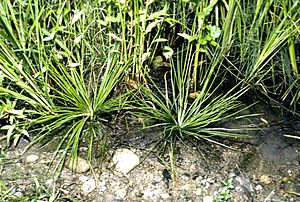Isoetes engelmannii facts for kids
Quick facts for kids Isoetes engelmannii |
|
|---|---|
 |
|
| Conservation status | |
| Scientific classification | |
| Genus: |
Isoetes
|
| Species: |
engelmannii
|
| Synonyms | |
|
Calamaria engelmannii (A.Braun) Kuntze |
|
Engelmann's quillwort (scientific name: Isoetes engelmannii) is a special kind of aquatic plant. This means it lives in water. It belongs to a plant family called Isoetaceae. People also call it the Appalachian quillwort.
This plant is the most common type of quillwort found in eastern North America. You can find it from Ontario, Canada, all the way south to Florida and west to Arkansas and Missouri in the United States. It likes to grow in wet places like temporary pools, bogs, marshes, and along streams or wet roadsides. You can usually spot it from April to October.
What Does It Look Like?
Engelmann's quillwort is a pteridophyte, which is a group of plants that includes ferns. It's a perennial, meaning it lives for more than two years. It grows partly out of the water.
Its rootstock, which is like a short, thick stem underground, is usually round and has two parts. The bright green leaves stay green all year. They are flexible and get lighter in color near the bottom. They slowly get thinner towards the tip.
These leaves are usually about 60 centimeters (about 2 feet) long, but they can be as short as 10 cm or as long as 90 cm. They grow in a spiral pattern.
The plant has special cases called sporangia that hold its spores. The wall of these cases usually has no color, but sometimes it might have brown streaks. A small flap called a velum covers less than a quarter of the sporangium.
The larger spores, called megaspores, are white and about 400 to 560 micrometers wide (that's super tiny!). They have a net-like texture. The smaller spores, called microspores, are gray and about 20 to 30 micrometers wide. They can be smooth or have tiny bumps. The spores become ready in the summer. This plant has 22 chromosomes.
Where Does It Live?
Engelmann's quillwort is found all over eastern North America. It's the most common type of quillwort in this area. In Canada, you can only find it in the very southern part of Ontario.
In the United States, its main home is from New Hampshire in the northeast, west to New York. There are also some groups of these plants further west in Michigan. The plant's range goes south along the Appalachian Mountains to the very north of Florida. It also reaches west into the mountains, touching the northeastern parts of Mississippi, Arkansas, and southeastern Missouri. It goes north into southern Indiana and Illinois. There's also a separate group of these plants in northeastern Ohio.
You can find this plant from April to October. It likes to grow in places that are wet, such as temporary pools (which dry up sometimes), bogs, marshes, along streams, in swamps, and even in wet ditches along roads. It also grows partly out of the water in shallow lakes and ponds.


